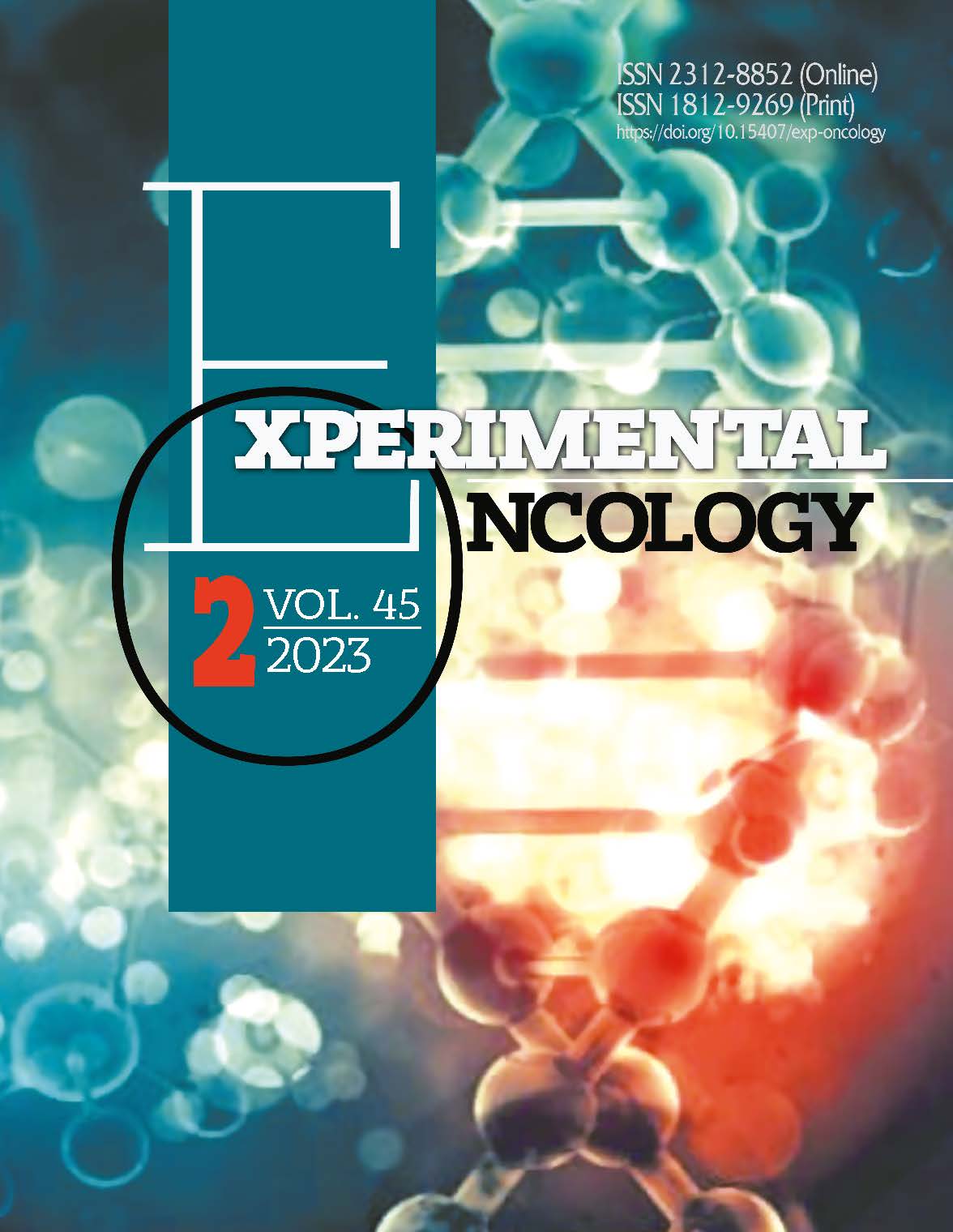ПОПЕРЕДЖЕННЯ ПАТОЛОГІЧНОГО ЕФЕКТУ ІШЕМІЇ-РЕПЕРФУЗІЇ ПРИ РЕЗЕКЦІЇ ПЕЧІНКИ ШЛЯХОМ ПОПЕРЕДНЬОГО КОНДИЦІЮВАННЯ СЕВОФЛУРАНОМ
DOI:
https://doi.org/10.15407/exp-oncology.2023.02.252Ключові слова:
колоректальний рак, метастази в печінку, ішемічно-реперфузійне ушкодження, прекондиціювання севофлураномАнотація
Актульність. Інтермітований маневр Прінгла залишається основним методом контролю крововтрати під час резекцій печінки. Такий підхід пов’язаний з ризиком запуску каскаду патологічних змін, що призводять до ефекту ішемічно-реперфузійного пошкодження (І/Р). Вважається, що перспективним методом корекції І/Р є фармакологічне попередження. Мета. Оцінити вплив фармакологічного прекондиціювання севофлюраном на післяопераційну функцію печінки. Матеріали та методи. Проспективне когортне дослідження включає аналіз даних 73 пацієнтів, що перенесли резекцію печінки. В основній групі за 30 хв. до резекції печінки проводили прекондиціювання інгаляцією севофлурану. У контрольній групі прекондиціювання севофлураном не проводили. Первинними кінцевими точками були концентрація лактату в крові після операції та через 1 добу; активність аланінамінотрансферази (АЛТ) і аспартатамінотрансферази (АСТ) на 1, 3 і 5-й післяопераційні дні. Результати. На 1-шу післяопераційну добу у пацієнтів групи прекондиціювання севофлураном вміст лактату знизився до передопераційного рівня, тоді як у контрольній групі він підвищився порівняно як з передопераційним рівнем, так і з рівнем одразу після резекції печінки. Достовірну різницю в рівнях АСТ між групами було зареєстровано на 5-й день, і вона не була клінічно значущою. Зниження протромбінового індексу в групі прекондиціювання севофлураном на 3-й день було вищим, ніж у контрольній групі. Множинний регресійний аналіз продемонстрував помірний позитивний зв’язок між кількістю резектованих сегментів печінки та маркерами функціонального стану печінки в групі прекондиціювання севофлураном, тоді як у контрольній групі такий зв’язок не був значущим. Висновки. Протек- торний вплив севофлурану на післяопераційну функцію печінки проявляється зниженням рівня лактату крові та стабільним рівнем трансаміназ.
Посилання
Jarnagin WR, Gonen M, Fong Y, et al. Improvement in perioperative outcome after hepatic resection: analysis of 1,803 consecutive cases over the past decade. Ann Surg. 2002;236:397-406. doi: 10.1097/01.SLA.0000029003.66466.B3
Man K, Fan ST, Ng IO, et al. Prospective evaluation of Pringle maneuver in hepatectomy for liver tumors by a randomized study. Ann Surg. 1997;226:704-711.
Jiménez-Castro MB, Cornide-Petronio ME, Gracia-Sancho J, Peralta C. Inflammasome-mediated inflammation in liver ischemia-reperfusion injury. Cells. 2019;8(10):1131. doi: 10.3390/cells8101131
Clavien PA, Selzner M, Rüdiger HA, et al. A prospective randomized study in 100 consecutive patients undergo- ing major liver resection with versus without ischemic preconditioning. Ann Surg. 2003;238(6):843-850; discus- sion 851-852. doi: 10.1097/01.sla.0000098620.27623.7d
Hogal RH, Mergental H, Mirza DF, Afford SC. The emerging importance of liver sinusoidal endothelial cells in regulating injury during machine perfusion of deceased liver donors. Semin Liver Dis. 2018;38(3):252-259. doi: 10.1055/s-0038-1661371
Koneru B, Fisher A, He Y, et al. Ischemic preconditioning in deceased donor liver transplantation: a prospective randomized clinical trial of safety and efficacy. Liver Transpl. 2005;11(2):196-202. doi: 10.1002/lt.20315
Koneru B, Shareef A, Dikdan G, et al. The ischemic preconditioning paradox in deceased donor liver transplanta- tion—evidence from a prospective randomized single blind clinical trial. Am J Transplant. 2007;7(12):2788-2796. doi: 10.1111/j.1600-6143.2007.02009.x
Boleslawski E, Vibert E, Pruvot FR, et al. Relevance of postoperative peak transaminase after elective hepatec- tomy. Ann Surg. 2014;260:815-820. doi: 10.1097/SLA.0000000000000942
van de Poll MC, Derikx JP, Buurman WA, et al. Liver manipulation causes hepatocyte injury and precedes sys- temic inflammation in patients undergoing liver resection. World J Surg. 2017; 31:2033-2038. doi: 10.1007/ s00268-007-9182-4
van den Broek MA, Shiri-Sverdlov R, Schreurs JJ, et al. Liver manipulation during liver surgery in humans is as- sociated with hepatocellular damage and hepatic inflammation. Liver Int. 2013;33:633-641. doi: 10.1111/liv.12051
Burlaka A, Paliichuk A, Makhmudov D, et al. Impact of the Pringle manoeuvre on the mitochondrial redox state of hepatocytes in colorectal cancer patients with liver metastases. Contemp Oncol (Pozn). 2021;25:185-190. doi: 10.5114/wo.2021.110050
Dmytriiev D, Dmytriiev K, Stoliarchuk O, Semenenko A. Multiple organ dysfunction syndrome: What do we know about pain management? A narrative review. Anaesth Pain Intensive Care. 2019;23(1):84-91.
Kuchyn IL. Spinal anesthesia with low doses of local anesthetic in patients with multiple trauma. Lik Sprava. 2014;(3-4):95-99 (in Ukrainian).
Müllenheim J, Ebel D, Frässdorf J, et al. Isoflurane preconditions myocardium against infarction via release of free radicals. Anesthesiology. 2002;96:934-940. doi: 10.1097/00000542-200204000-00022
Tanaka K, Ludwig LM, Kersten JR, et al. Mechanisms of cardioprotection by volatile anesthetics. Anesthesiology. 2004;100:707-721. doi: 10.1097/00000542-200403000-00035
Beck-Schimmer B, Breitenstein S, Urech S, et al. A randomized controlled trial on pharmacological pre- conditioning in liver surgery using a volatile anesthetic. Ann Surg. 2008;248:909-918. doi: 10.1097/ SLA.0b013e31818f3dda
Barrier A, Olaya N, Chiappini F, et al. Ischemic preconditioning modulates the expression of several genes, lead- ing to the overproduction of IL-1Ra, iNOS, and Bcl-2 in a human model of liver ischemia-reperfusion. FASEB J. 2005;19:1617–1626. doi: 10.1096/fj.04-3445com
Kunst G, Klein AA. Peri-operative anaesthetic myocardial preconditioning and protection - cellular mechanisms and clinical relevance in cardiac anaesthesia. Anaesthesia. 2015;70(4):467-482. doi: 10.1111/anae.12975
Toda N, Toda H, Hatano Y. Anesthetic modulation of immune reactions mediated by nitric oxide. J Anesth. 2008; 22:155-162. doi: 10.1007/s00540-007-0590-2
Slankamenac K, Breitenstein S, Beck-Schimmer B, et al. Does pharmacological conditioning with the volatile anaesthetic sevoflurane offer protection in liver surgery? HPB (Oxford). 2012;14:854-862. doi: 10.1111/j.1477- 2574.2012.00570.x
Figueira ERR, Rocha-Filho JA, Lanchotte C, et al. Sevoflurane preconditioning plus postconditioning decreases inflammatory response with hemodynamic recovery in experimental liver ischemia reperfusion. Gastroenterol Res Pract. 2019;2019:5758984. doi: 10.1155/2019/5758984
Nguyen TM, Fleyfel M, Boleslawski E. Effect of pharmacological preconditioning with sevoflurane during hepatec- tomy with intermittent portal triad clamping. HPB (Oxford). 2019;21:1194-1202. doi: 10.1016/j.hpb.2019.01.009
Rahbari NN, Garden OJ, Padbury R, et al. Posthepatectomy liver failure: a definition and grading by the interna- tional study group of liver surgery (ISGLS). Surgery. 2011;149:713-724. doi: 10.1016/j.surg.2010.10.001
Mullen JT, Ribero D, Reddy SK, et al. Hepatic insufficiency and mortality in 1,059 noncirrhotic patients undergo- ing major hepatectomy. J Am Coll Surg. 2007;204:854-862. doi: 10.1016/j.jamcollsurg.2006.12.032
Riess ML, Kevin LG, Camara AK, et al. Dual exposure to sevoflurane improves anesthetic preconditioning in in- tact hearts. Anesthesiology. 2004;100:569-574. doi: 10.1097/00000542-200403000-00016
Riess ML, Eells JT, Kevin LG, et al. Attenuation of mitochondrial respiration by sevoflurane in isolated car- diac mitochondria is mediated in part by reactive oxygen species. Anesthesiology. 2004;100:498-505. doi: 10.1097/00000542-200403000-00007
Obal D, Preckel B, Scharbatke H, et al. One MAC of sevoflurane provides protection against reperfusion injury in the rat heart in vivo. Br J Anaesth. 2001;87:905-911. doi: 10.1093/bja/87.6.905
Zitta K, Meybohm P, Bein B, et al. Cytoprotective effects of the volatile anesthetic sevoflurane are highly depen- dent on timing and duration of sevoflurane conditioning: findings from a human, in-vitro hypoxia model. Eur J Pharmacol. 2010;645:39-46. doi: 10.1016/j.ejphar.2010.07.017
Lisnyy I, Zakalska K, Melnyk V, et al. Assessment and correction of liver function in liver resection. Lek Obz. 2021;70(9):297-303.
Submitted: February 22, 2023
##submission.downloads##
Опубліковано
Як цитувати
Номер
Розділ
Ліцензія
Авторське право (c) 2023 Експериментальна онкологія

Ця робота ліцензується відповідно до Creative Commons Attribution-NonCommercial 4.0 International License.



